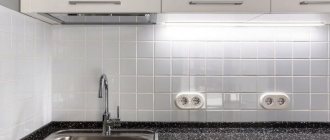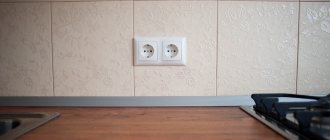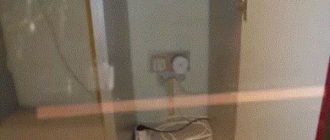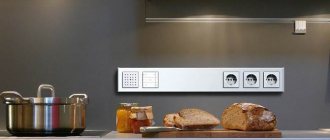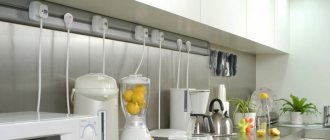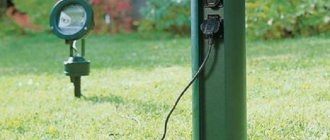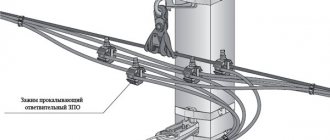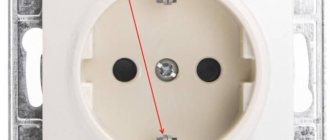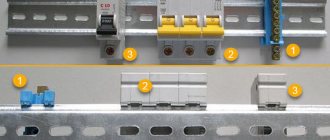General concepts of connecting equipment
Household appliances for the kitchen, which are powered from the mains, have quite a lot of power to prepare a delicious dinner without any problems. The lowest consumption is 2.5 kW. But sometimes it is necessary to connect a device up to 10 kW to the network. Therefore, according to modern electrical safety requirements, a separate power line from the panel must be connected to such consumers in the apartment.
A socket for an electric hob will require a connection to the general network, independent of the oven. An important role in the process of arranging kitchen equipment is played by the characteristics inherent in a particular technique. Hobs can be single-phase, three-phase and have different powers.
Usually a plug is not included in the package. Even the wire may be missing when selling equipment. Therefore, it is possible to connect it directly to the panel or simply to the machine. However, some home owners decide to do things differently and carry out the work in a slightly more complex way.
Power of electrical appliances in the kitchen
To do this, the power of all electrical appliances that will be in the kitchen is initially calculated. Here is an approximate list of them:
- lighting – 150-200 Watt
- Microwave – 2000 Watt
- Refrigerator – 100 Watt
- Dishwasher – 1000-2000 Watt
- Electric kettle – 2000 Watt
- Oven – 2000 Watt
- Water heater – 2000 Watt
- Hob – 3500-7500 Watt
But you must calculate the total power. Most often it is in the range of 10-15 watts. The maximum power, when several pantographs are switched on simultaneously, in an ordinary apartment, as a rule, does not exceed 7 kW. If your power is higher than 7 kW, then you need to think about inputting 380V and distributing the load.
Connection type
To understand which outlet is needed for the hob, you need to determine what type of connection is provided in this model. A device with a power not exceeding 3.5 kW can be connected to a standard 220 V connection. This equals 16 A load. If the kit includes a wire and a plug, then they usually meet the requirements of a typical apartment electrical network.
If the equipment power exceeds 3.6 kW, then a reinforced installation of at least 32 A will be required, which can be compared with a 220 V network.
If the apartment has a three-phase power supply system, then a 20 A socket is purchased for devices up to 3.5 kW of power. If its characteristics indicate energy consumption of more than 3.6 kW per hour of operation, enhanced equipment will be required. The three-phase plug and socket must be 32 A.
It must be taken into account that the hob will definitely require grounding. Therefore, the socket must have an outlet for additional plug pins. A single-phase socket has 3, and a three-phase socket has 5.
That is why conventional installations suitable for lighting are simply unacceptable for this type of kitchen equipment.
Socket
Kitchen appliances with a power of more than 3.5 kW are connected to electricity through special power sockets (the power of the equipment is indicated in the technical documentation). Manufacturers produce several varieties of such sockets, but their main difference from ordinary household ones is their ability to work with high power currents.
Electric stoves and ovens are made using external metal parts, which become energized when electricity breaks down on the body. Grounding is used to protect the user from electric shock.
Attention! Ovens and hobs are connected through grounding. The socket or plug for such equipment has 3 or 5 contacts (in the first case - for a 220 Volt network, in the second - for 380 Volts).
There are single-phase power sockets and three-phase ones. The first ones supply a phase, a working zero and a ground wire to the device. The latter are designed for 5 contacts and can withstand a current of at least 32 A.
Kinds
According to the installation method, there are 3 types of components: hidden, overhead and combined:
- Hidden. For hidden installation, the socket box is mounted into the wall. This hides the working surface of the outlet, which increases the safety of its use and reduces the risk of moisture and dirt getting in.
- Invoice. Components of this type are mounted on top of the bends. As a result, the outlet protrudes above the wall surface and is not protected from moisture, dust and grease.
- Combined. This type is a hidden outlet, additionally protected from external factors by a cover.
By design, power sockets can be single or double. Double ones are convenient because, if necessary, additional kitchen appliances (mixer, microwave, hood, etc.) can be connected to them.
Sockets vary in the amount of current they are designed to handle. There are products for 25 A, 32 A, 63 A and 125 A. The power is selected in accordance with the power consumption of the equipment.
Types of installation
Hob sockets can be installed above appliances, but not behind them. Otherwise, there will be problems with placing the equipment flush with the kitchen furniture.
Installation can be hidden or external. If the walls of the house are made of wood, all wires and system elements are carried out only externally. In ordinary houses there are no special requirements for the choice of communications. It depends on the taste preferences of the owners.
Experts say that hidden installation of an outlet, although more labor-intensive, is safe for users. If the repair was carried out a long time ago and there are no plans to open the network channels in the near future, an external connection to the outlet will do. To hide the wire, you need to use special channel boxes.
At what height should they be made?
Experts recommend adhering to a three-level scheme, considering it the most successful model:
- The lower level is occupied by large household appliances. Such sockets are located at a height from the floor of approximately 10-30 cm.
- The next level— intermediate —occupies the bulk of the equipment. Most often they use sockets that are located above the working surface of tables, this is convenient. According to the rules, they should be at a height of 10-20 cm above the tabletop.
- And at the very top level there are sockets for the kitchen hood, as well as lighting devices connected via an electric plug. Here the height is at least 2 m from the floor level.
What kind of socket is needed for the hob?
Often such equipment is not equipped with a fork at all. It is more expedient to connect it to a separate power line, equipped with a panel with a circuit breaker and a residual current device (RCD).
Electric hobs can be equipped with a cable, but more often they are supposed to be connected to the network directly through the terminal blocks. If there is a plug or the user for some reason considers a classic socket a more convenient option, it is important to carefully study the operating instructions. Particular attention is paid to the technical specifications section, where the power of the device is indicated.
General requirements for the outlet
Much depends on the type of network connection. So, with single-phase, the following parameters are relevant:
- for a panel with a power of up to 3.5 kW you need a 16 A socket;
- up to 5.5 kW - 25 A;
- do not exceed 7.2 kW - 32 A;
- up to 8.8 kW - 40 A.
With three-phase:
- up to 3.5 kW - 20 A;
- up to 7 kW -32 A.
It is unacceptable to use sockets without a grounding contact.
What kind of wire is needed
Regardless of the number of phases and, accordingly, the number of cores in the cable, the use of aluminum wires is strictly prohibited. Only copper.
Strict adherence to the recommended section is also mandatory, because safety is at stake. Yes, for:
- panels with a power of up to 3.5 kW use cables with a core diameter of 2.5 mm;
- up to 5.5 kW - 4 mm;
- no more than 7.2 kW - 6 mm;
- up to 8.8 kW - 10 mm.
Knowing the symbols will help you avoid confusion with multi-core cables when connecting an electric hob to the network. Zero is marked with the letter N on the diagram and with blue (less often gray) insulation of the core. Grounding corresponds to a yellow-green or simply green color and the designation PEN (PE). Sometimes on the diagram the ground is not marked with letters, but this does not make it any more difficult to figure out. Phase L corresponds to wires of black, brown and red colors.
When choosing a place to install an outlet, it is better to stay above the panel or to the side of it. A hidden location, for example, under a stove, is also acceptable, but in this case you should consider options for quick access to it.
Socket for oven and hob
Sockets for the hob that can withstand power greater than 20 A are considered power sockets. Based on the installation method, they are divided into overhead and internal. Overlays are installed on the wall. They are convenient to use when laying wiring using the air method. They are not dangerous for wooden buildings and in rooms with a lot of moisture. They are not afraid of dust and moisture. Internal ones are installed in socket boxes mounted into the wall. Your technician will advise you which sockets to use.
Before purchasing an outlet for an oven and hob, you need to make a choice based on calculating the maximum voltage. For example, for household stoves up to 3.5 kW, 15 A is enough, for an electric stove 9 kW - above 33. For equipment with higher power - 65 A. For such purposes, the socket is provided with appropriate thick pins, and the insulation is made with fireproof material.
You also need to determine how many phases will work. To work with a voltage of 220 V, three connectors are needed, with a voltage of 380 V - five.
The feeder is connected to the plug using different methods. The first is that the cord core is freed from the sheath by less than a centimeter, inserted under the clamp and clamped with a screw. The second is more reliable: the wire is stripped of insulation by more than a centimeter, and a screw is wrapped with it, after which it is pressed. The area where the wire touches is larger, and therefore the contact is better. All these processes allow you to connect the oven and electric stove to one cable, therefore, everything is connected to one outlet.
It is better to install the socket near the hob, observing conditions that protect against the ingress of liquid or water. There should be free access to it with maximum secrecy.
Which cable to choose for the kitchen
Next, you need to calculate the cross-section of the common supply wire of the electrical panel and the outgoing wiring to each pantograph. Follow the rules here:
- for device loads up to 3.5 kW - copper cable VVGng-Ls 3*2.5mm2
- for device loads up to 5.5 kW - copper cable VVGng-Ls 3*4mm2
- with a total load of all devices up to 10 kW - copper cable VVGng-Ls 3*6mm2
- with a total load of all devices up to 15 kW - copper cable VVGng-Ls 3*10mm2
Why there should be a brand VVGnG-Ls is discussed in detail in the article below:
Even if you have a house with an old grounding system (without a third protective conductor), still do the wiring with a 3-core cable. This will save you in the future from additional costs for reconstruction and replacement of wires.
As a last resort, the third wire will be a backup for zero or phase, in case of a possible break or other damage.
Choosing a socket and plug for the hob
Hobs consume on average 7-8 kW. This indicator corresponds to a current of 32-38A. At the same time, ordinary sockets and plugs for household electrical appliances are designed for a current of 16A-25A. Therefore, to connect electric stoves and ovens, special power sockets and plugs for hobs are used that support large cross-section cables (4-6 mm²).
There are several types of components on sale that meet these requirements. To connect hobs, the RSh/VSh-32 connector is most often used. There are two types of such sockets and plugs: for connecting to a single-phase network and for connecting to a three-phase network.
Attention! The socket for connecting the hob is selected based on the characteristics of a particular model. The power of the panels ranges from 3.5 to 10 kW. The higher the energy consumption, the more severe the demands placed on components and wiring.
Thus, having bought a new stove, it is not plugged into the first outlet that comes across. For uninterrupted and safe operation of the device, special components are required.
For induction hob
The average load of an induction cooker is 25-32 A, depending on the number and power of burners. Therefore, to connect the device, use a power outlet with a dedicated wiring line. The cross-section of the cable used depends on the load of the device: for a current of 25 A, a copper cable with a cross-section of 4 square meters is used. mm, for a load of 32 A - 6 sq. mm.
Important! For safe operation of the hob, electrical wiring with protective grounding is required. This means that for a single-phase network a three-core cable is supplied, and the power socket and plug set used has a third grounding contact.
For table top induction cooker
A tabletop induction electric stove is a low-power device that has a cord and plug for connection to a regular household outlet; there is no need to install a special power outlet. But first it’s worth assessing the condition of the socket box and electrical wiring. If the plug of an electrical appliance does not make good contact with the connectors, replace the socket. You also need to make sure that the electrical wiring is in good condition and that the connected cable has a cross-section of at least 2.5 square meters. mm.
For gas hob
A gas hob connection to the mains is required if the appliance is equipped with an electric ignition function. In this case, install a separate 16 A socket with grounding, connected to the circuit breaker on the panel.
The socket box is installed on the wall under the table top. If the cabinet has a blank wall under the stove, a hole is cut out in it for free access to the equipment.
Basic requirements for placing sockets in the kitchen
Since electricity is considered potentially dangerous, special standards and requirements have been developed that must be taken into account when designing. Here are the main points.
- The connected device cannot be located further than 1.5 m from the power source.
- The electrical connector must be protected as much as possible from moisture, steam and splashes. Therefore, it should be removed from the stove and sink at a distance of at least 200 mm.
- For built-in appliances, it is allowed to install sockets in adjacent furniture cases. To do this, suitable holes are cut into them at a height of 300-600 mm from the floor.
- It is allowed to install electrical components inside a cabinet with a sink. In this case, only designs with special waterproof housings are used.
- In the kitchen, the height of sockets installed on the apron should be 150-250 mm from the level of the countertop. This way they will get a minimum of splashes.
It is prohibited to install electrical outlets directly behind the body of any built-in appliances, behind the sink or behind drawers. This ban is especially relevant for dishwashers and washing machines.
Single-phase and three-phase connection
Appliances operating up to 3.5 kW operate from a standard 16 A/220 V socket connector. An ordinary cable and a 16 amp plug are connected to the ovens, of course, if the connection is independent, because of this, only such a socket can be used.
The hob kit does not include a plug, so you will have to look for not only an outlet, but also a plug. If the operation of an electric stove requires at least 3.6 -7 kW, only a power outlet with 32 A/220 V capabilities and a special 32 A plug are suitable.
Ovens operate at a voltage of 380 V. When the voltage does not exceed 3.5 kW, the three-phase socket includes 20 A, at a voltage from 3.6 to 7 kW - 20 A. If the manufacturer does not include a three-phase plug with exactly the same number of amperes, it must be purchased separately.
The sockets and plugs of such devices are grounded, therefore, they include a large number of pins and holes. If you connect an ungrounded device, this can pose a threat to health and life.
Determination of the number of nests
The placement of sockets is subject to certain rules to prevent short circuits and wiring fires.
When determining the required number of sockets in a kitchen apron, you need to use simple mathematical rules.
The required indicator will consist of the following terms:
- Appliances that are constantly connected: stove, microwave, coffee maker, hood, lamp, kettle.
- Devices used as needed: washing machine, dishwasher, bread machine, multicooker, toaster, food processor, coffee grinder.
- Reserve. It is intended for connecting a soldering iron, vacuum cleaner or other products for occasional work.
You should not make many sockets for each of the available devices - this will lead to unnecessary costs and cluttering of the headset. The best option is to have sockets at maximum kitchen load plus 1-2 backup inputs. It is better to have a small reserve, since after installation it will not be possible to change anything, and using extension cords and tees is not the best solution.
Installation location and rules
Before installing sockets, you should analyze the space in the kitchen, since there should not be a sink, drain or water pipes nearby. You cannot make a socket right behind the wall of the oven (where it can heat up), or mount it above the countertop level. According to European standards, a height of 15 cm above floor level is optimal. However, you should not take this recommendation literally. Usually they start from existing conditions and goals. The best location is considered to be the wall area below the working surface, if there is normal access to it. They also try to place the outlet away from the refrigerator and stove. Such measures reduce the risk of short circuit.
Some electricians suggest not installing separate power outlets, but instead powering the oven or panel using an extension cord. Do not follow such advice as it may create a fire hazard. The well-being of all family members depends on how correctly electrical equipment is connected.
How we perform the service
Poor installation, as well as incorrect placement of sockets in the kitchen, can negatively affect the performance characteristics of expensive electrical equipment and, even worse, pose a threat to the safety of residents. Therefore, it is better to entrust this work to professionals. If you need to move sockets, our company’s specialists will do the job efficiently and with a guarantee. Read more about] elektrikclub.ru/perenos-rozetok-na-kuhne[/anchor]
Our craftsmen will perform high-quality installation of sockets in the kitchen area in compliance with established standards and requirements and providing a guarantee for work and materials.
Socket box
When deciding which outlet to choose for the hob, you need to decide on the choice of its additional elements. This is a socket box and an RCD. The box for wall mounting can be surface-mounted or built-in. In the first case, communications are connected externally, and in the second, they are hidden in the thickness of the wall.
The characteristics of the socket box must match the type of installation itself. For internal installation, a special box is also needed.
If the socket is designed for 20 A power, the socket box must be with the same marking. Preference should be given to more expensive, but high-quality products. After all, the health and life of home owners depends on it.
RCD and automatic
The rules for operating powerful kitchen appliances require the use of a device such as a residual current device (RCD) and an automatic machine in the network. This will prevent accidents in case of possible violation of the integrity of the conductors and protect against electric shock.
The machine is selected according to the type of hob. If the equipment is characterized by average power, a single-phase 20 A circuit breaker is installed in the network. If the equipment consumes from 4 kW per hour, then a voltage cut-off device must be purchased at 32 A. In this case, the RCD must be selected one point higher than the rating of the machine. If the switch, for example, is rated at 32 A, then the residual current device must be purchased with parameters of 40 A.
Only an electrician should select equipment and connection elements for the kitchen equipment presented. Dealing with such issues on your own, without even having basic knowledge about such things, is life-threatening.
Installation instructions
Installation of reinforced components for electric and induction cookers is trusted to specialists. But if you have experience, you can handle it yourself. Installation involves performing the following steps:
- Turn off the power to the cable you will be working with. After a power outage, be sure to check that there is indeed no current in the wire.
- In the selected location, using a puncher, make a hole for the socket cup (for a hidden power socket).
- The power cable is threaded into the socket box and the protective braiding is removed from it. The freed wires are stripped to 0.8-1 cm.
- Connect the wires to the socket mechanism. The yellow-green wire responsible for the “ground” is attached to the central grounding contact. “Phase” and “zero” are connected to the extreme contacts.
- After the wires are secured, the socket box is firmly fixed in the wall using gypsum mortar.
- When the solution dries, the mechanism is secured with screws and the upper insulating housing of the power outlet is installed.
At this point, the installation process is considered complete. Now connect the power and check if the equipment works.
Some tips for connecting
The manufacturer's instructions stipulate a mandatory grounding connection for the hob. In accordance with this, its appearance is somewhat different from the usual types of installations. A photo of the outlet for the hob, which is grounded, is presented below.
Under no circumstances should you use this technique if there is no grounding or if it is not done correctly. It is strictly forbidden to connect the conductor to pipes or risers. Grounding according to this scheme is dangerous to life.
If you purchased equipment with a wire for a three-phase product, but the apartment has a single-phase network, you can get out of this difficult situation. The black and brown wires that come with the hob are connected together through a terminal. This will be the phase wire. Then everything is connected as usual.
Frequent connection errors
If, after connecting, the panel starts to work in an unknown way - it turns itself off, and after a few seconds it can turn on again. Do not rush to commit incorrect installation.
It is quite possible that the child lock is set in the program, water was spilled on the sensors, or the wrong buttons were accidentally pressed. Some models have a dish recognition function. Until you place the pan on the burner, it will not heat up.
Another common problem is that only two of the four burners work, and the rest show residual heat (the letter H is displayed). This is due to blocking during single-phase connection of three-phase models.
This way the power is limited by software.
Therefore, first thoroughly understand the documentation and only then go back to the connection terminal block.
Is it possible to connect two kitchen appliances to one power socket?
With proper electrical wiring, these devices are connected to the terminal for the electric stove. Often, craftsmen resort to cutting off the plug from the oven and connecting the device to the electrical network using terminals. The disadvantage of this method is that in this case the warranty on the oven is lost due to damage to the plug.
Another way to connect these two devices is to install an additional socket on the oven and on the hob separately. But this must be foreseen at the repair stage. Not all homeowners think through such things at the renovation stage, without planning the location of the furniture in the kitchen.
The third method can solve these inconveniences simply. In this case, there is no need for preliminary preparations, installing auxiliary sockets or damaging the plug feeder. In this case, there is no need to remove the power feeder. To connect the hob and oven, a compound socket is used, which combines a power connector for an electric stove and a classic European socket for an electric oven.
This socket model is superimposed on top of the standard one. A dilemma arises: what cable is needed to connect it? The answer is a regular electrical cable for a cooking device, where you can immediately connect a baking cabinet, but its power cannot exceed 3 kW. Simply put, they are connected to one cable.
The factory feeder is equipped with marked conductors: white, blue and yellow-green. To power the oven electrically you will also need:
- Socket box.
- Socket for electric oven.
- Plug (not included in the set).
To avoid the possibility of electric shock, control is entrusted to the circuit breaker and RCD. It is better to purchase it in advance for the shield. If it is necessary to connect the oven and hob, use a differential switch that can withstand the total load. The socket should be installed at an optimal and accessible height (one meter from the floor), but it should not be installed behind the oven. The best option is on both sides of the device.
In the bathroom
The second problematic room for electricians is the bathroom. But the problems here are of a different nature - high humidity and the possibility of water ingress. To understand where to put sockets in the bathroom, you need to know where to place household appliances. The bathroom space is divided into zones (see photo).
Dividing the bathroom into zones
Zone 0 is the highest probability of water entry. These are areas directly adjacent to the bathtub, shower stall, and sink. In this zone, you can only install 12 V sockets. But such voltage is supplied extremely rarely in private homes. There are simply no sockets here at all.
In zone 1, installation of water heaters is allowed. In zone 2, in addition to boilers, you can install fans and lamps. And the sockets should be in zone 3 - at a distance of at least 60 cm from the water source. It is necessary to install special sockets and switches, the degree of protection of which allows them to be used in wet rooms. Also a prerequisite is the presence of grounding, a circuit breaker and an RCD with a leakage current of 10 mA.
How to arrange sockets in the bathroom
The height of the sockets from the floor is again not regulated, but it makes sense to place them higher to minimize the possibility of water ingress. Even if you install special sockets with covers, it’s better to be safe.
